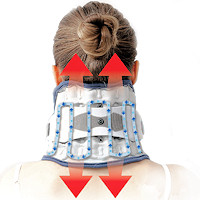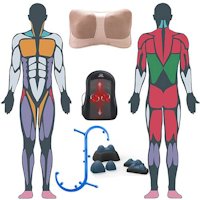The Basics of Neck Pain
Do you have neck stiffness when you wake up in the morning? Maybe the neck muscles go into spasm for no apparent reason. Perhaps the neck and upper back pain are a continuous nagging ache.
If you experience neck pain, you are not alone. According to the British Medical Journal, it is one of the top five chronic pain conditions in prevalence and years lost to disability. It is estimated by doctors that 7 of 10 individuals will experience neck pain during their lifetime. 1 of 20 of these individuals will have it effect their daily and work activities due to the longstanding nature and bothersomeness of chronic neck pain. Most often, it will often not be a one time experience, 50 to 85 percent of individuals will have another experience within 5 years.
It is common because it has to support the head, weighing about 10 to 12 pounds, yet must permit the head to be able to move up and down, tilt and turn. So, the neck must combine this flexibility of motion with strength for support. This combination is achieved with a system nerves, tendons, bones, and muscles that work in a complex manner. The nature of this system means the neck is prone to injuries and strains, especially the effects of poor posture over long periods like forward head posture or military neck. A problem with one part has effects by compensation on other parts.

If there is any good news involving, even though it is a painful and sometimes ability limiting condition, it is usually not a serious condition resulting in disability or requiring immediate medical attention. While chronic or long standing neck pain is often difficult to resolve, most commonly, symptoms resolve quickly with minor attention. Most types are able to be relieved and/or managed with simple home treatments like ergonomics, posture modification, well designed pillows, and other products designed to alleviate neck pain, as well as and over the counter pain relievers.
Over the years, there has been a trend towards individuals taking an active part in recovery as well as prevention. Taking responsibility to be more active has been noted to improve results. While an initial period of rest and supports like collars can be beneficial, returning to normal activities as soon as possible with the help of effective home use products, medications and therapies like chiropractic and physical therapy is usually preferred, and can help prevent an acute or recent episode from becoming chronic or long standing. Exercises that include stretching, strengthening as well as general exercise continues to show benefits in scientific studies in both treatment and prevention. Sometimes, to provide relief when other traditional therapies fail, surgery is required.
At NeckSolutions, we learn about ways to manage and prevent neck pain, ways to help your health professional diagnose, options for treatments as well as simple measures you can employ and effective products that can help. We also do the same for back pain. There are new methods being discovered and tested all the time and we try to keep up with them, presenting new options, products and methods and information.
As a chiropractor, I always recommend competent care for potential benefits. In a 2020 Review in Chiropractic & Manual Therapies found 7 themes of beneficial effects 1) positive change in muscle activity; 2) increase in mobility; 3) decrease in pain; 4) increase in pressure pain threshold; 5) change in spinal tissue behavior; 6) change in the central nervous system or reflex pathways; and 7) correction of a vertebral dysfunction.

 Neck Traction Devices
Neck Traction Devices Cervical Pillows
Cervical Pillows Muscle Therapy Tools
Muscle Therapy Tools